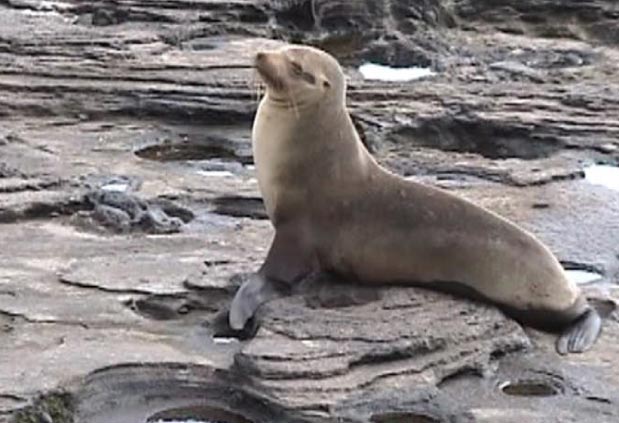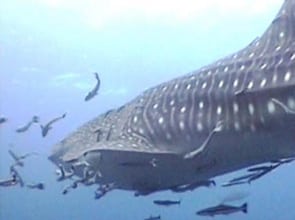
Big Fish, Big Risk Diving in the Galapagos
July, 1999
Rick and son Brett Crandall, Perry Klein and Tim Sedmak, four dive buddies over many years, had the adventure of their lives on an advanced scuba diving week to the very remote, north islands (called Wolf and Darwin) of the Galapagos archipelago. This is a story of major animal encounter and escaping a deadly threat of nature.
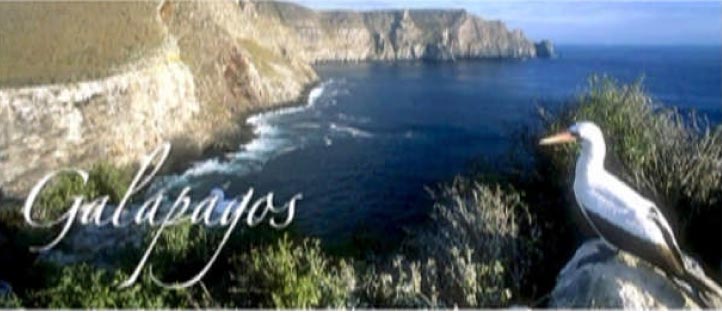
Volcanic in origin, the Galapagos comprise the tops of still-active volcanoes that rise from the ocean floor 1 ½ miles below. Straddling the equator some nearly 500 miles off the west coast of South America where the cold Humboldt and several other major ocean currents converge, the Galapagos nurtures one of the richest and most diverse marine ecosystems in the world.
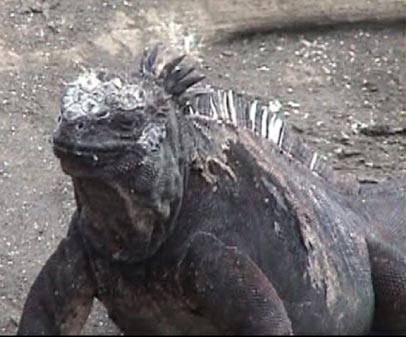
Above: Galapagos Land Iguana
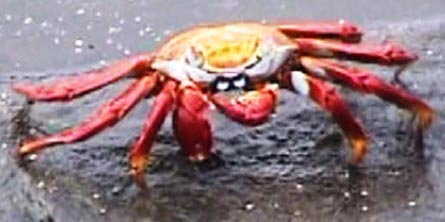
Brilliant red crabs – almost looked pre-cooked.
Lammer Law – Our Boat
The gateway to the Galapagos is Ecuador (owner of the islands). We flew from Ecuador to the Galapagos and secured our boat, one of the largest trimarans in the world, the Lammer Law.
Lammer is designed and built for diving and sailing. It is 93 feet in length with a 42 foot beam and fitted with compressors, chase pangas and everything an experienced diver would want.
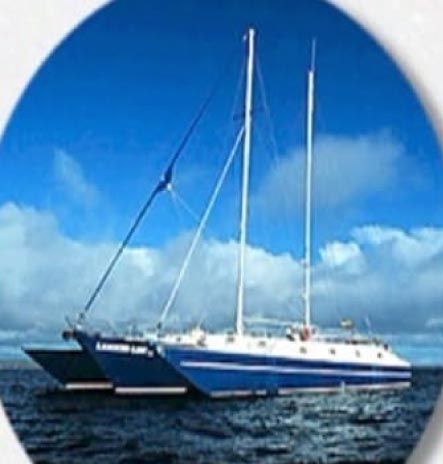
Above: Lammer Law trimaran

Tim Sedmak and Perry Klein, long time dive buddies
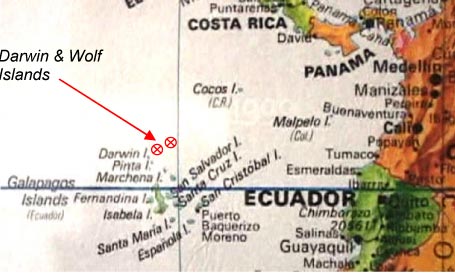
Galapagos archipelago
130 miles north of the main archipelago are the northern-most islands of Darwin and Wolf, which rank among the best dive sites in the world. Their distance from the other islands means they are only visited by advanced live-aboard cruises for diving. Strong currents prevail, bringing in a variety of sea life that provides the food chain attracting the larger animals.
Wolf Island
A 14 hour overnight voyage north from the main islands brought us to Wolf Island. Exposed to waves and strong shifting currents, Wolf is for advanced divers only. With its dives close to large animals, this area has topped the list of favorite advanced sites. Due to the unique blend of cold and warmer currents there are many fish found nowhere else. These include unusual species of turtles, rays, dolphins, schools of jacks and invertebrates.
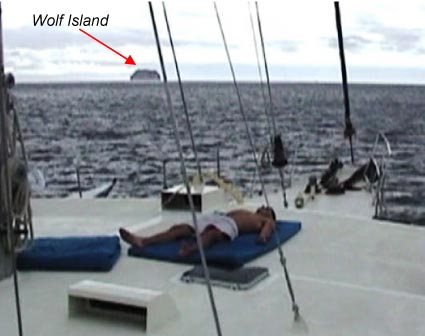
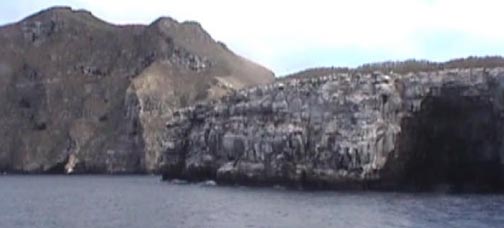
Wolf Island up close at a dive site
What make these sites truly incredible are the sharks – Galapagos sharks, Silkies, Hammerheads, and occasionally present is the largest fish in the sea, the Whale Shark. This is one of the few places in the world where 12 – 15’ hammerhead sharks actually school in the hundreds, swimming in a never ending parade.
So then the fun began. We got a briefing from the accompanying naturalist and dive leader with a chalkboard warning of strong currents and the necessity of keeping the submerged walls of the island always in view.
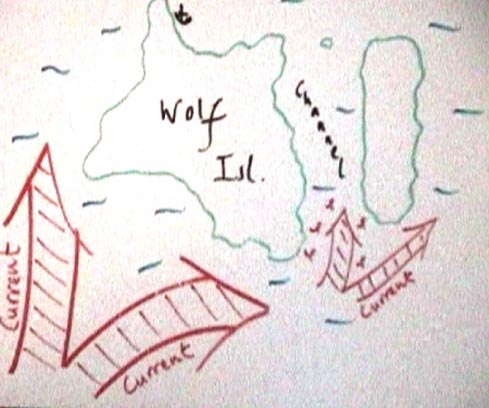
Daily Briefing Map sample
In we went, in full heavy wet suits with hoods to insulate us from the cold waters, especially in the thermo-clines.
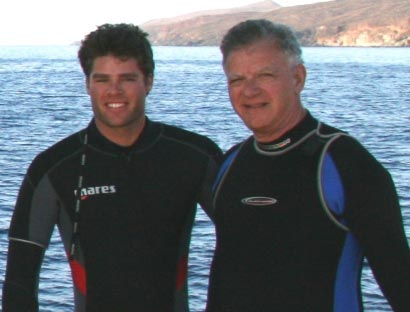
Brett and Rick ready for action.
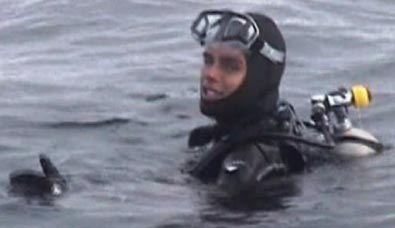
Brett ready for the cold below
At first we find fairly typical diving as we pass through 40’ through large schools of yellow-tails, sting rays and a Galapagos sea turtle waving to greet us.
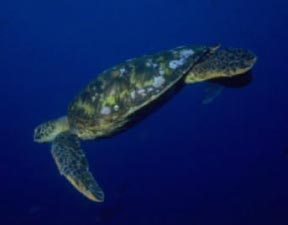
These were definitely not the clear waters of the South Pacific or the Caribbean, so we hadn’t yet gotten the feel for what lies below. We also had to accommodate to the currents, they were stronger than even a good swimmer could compete with and staying close to rock walls was good advice.
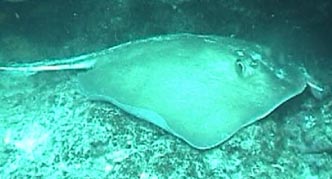
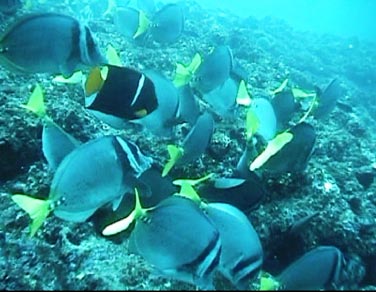
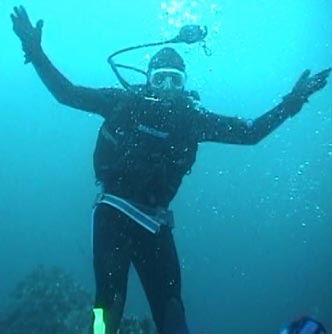
Rick rejoicing to be back in the underwater world he’s enjoyed for 40 years

Then as we passed along a sandy shelf at about 50′ heading towards a deeper drop-off, we spotted a nice 8 or 9′ Galapagos shark – first blood in the big animal category! Exciting … we were 15 minutes into our first dive.
The Hammerhead Sharks
Just a few minutes later we swam to a drop-off that took us down to about 80’ and then we were really into the action – hammerheads right in our face!
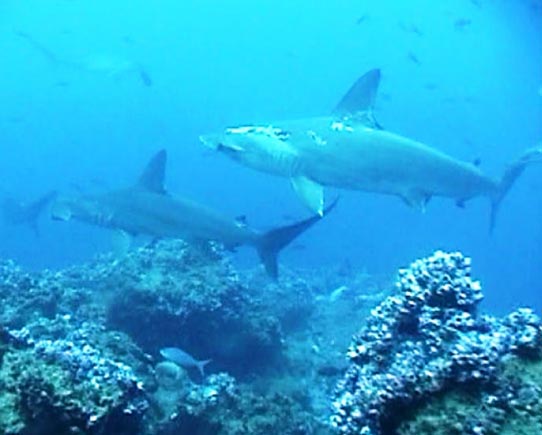
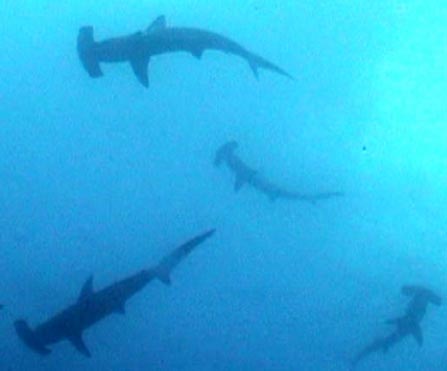
After the initial wave of excitement, we took the time to look around – they were above us, below us and even in our face – for dive after dive over the next several days.
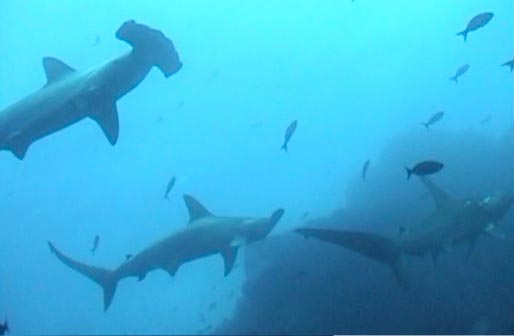
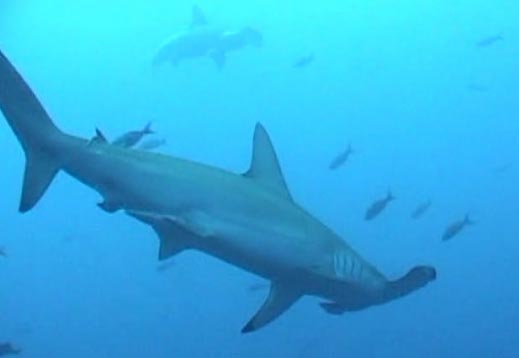
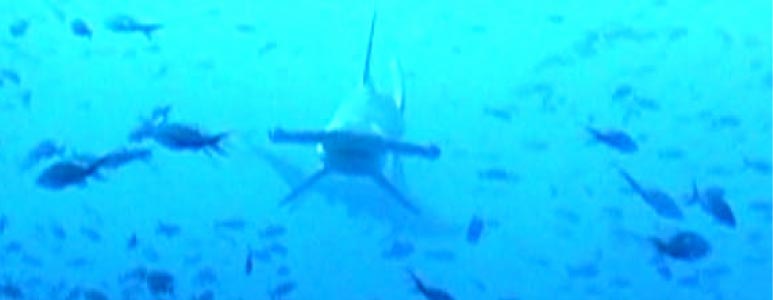
This one was acting a little too personal, but interestingly, by blowing bubbles from your air tank actually scares them away
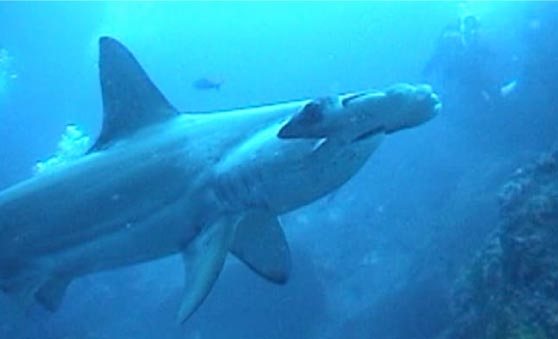
Up close …
… and personal
…. And BIG!
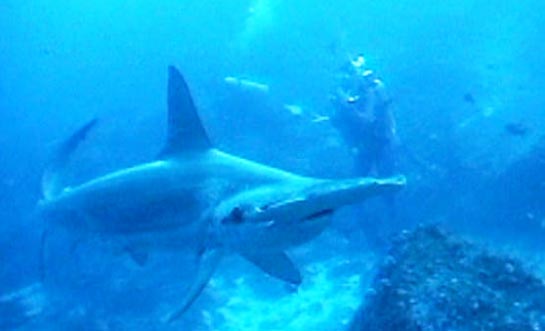
Darwin Island
We never tired of swimming with the sharks at Wolf Island, but we had more adventure ahead of us at Darwin Island, also a remote chunk of rock. Named for the island’s most famous visitor Darwin it is 4 hours north of Wolf. As the furthest north of the islands the Humboldt Current has little effect here and the waters are warmer than in the south as such there are other sea life to meet. Darwin’s fish encounters can be overwhelming. Those returning on board are usually in awe of this magnificent area.
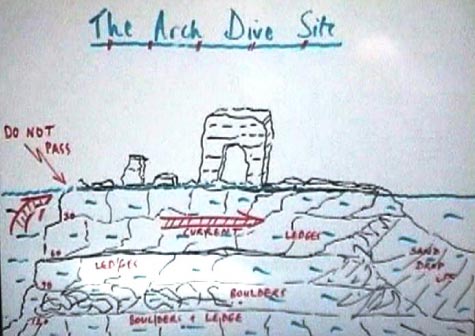
Then there is the treacherous Darwin’s Arch that looks almost adjacent to Darwin Island but it sits just above the surface on an underwater plateau. The steep barnacle covered walls drop off to the deeper ocean. The plateau is loaded with stones and boulders right at the surface, which combined with the strong currents makes for a highly dangerous churn into which no boat must ever venture, the risk being chewed up by the churn against the rocks.
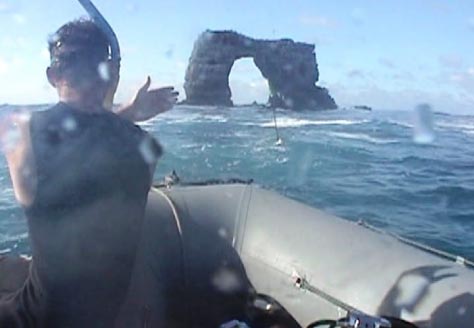
The Arch is a highly reputed dive site for advanced diving with big animals, and so we ventured towards it.
The inflatable boat you see they call a “panga” which are maneuverable boats with an outboard motor and grab lines on the outsides for divers to hold on to.
On the way to the dive site, we spotted floating markers connected to miles of illegal fishing lines (we learned later they were set by poachers on a Chilean fishing vessel who are generally employed by the Japanese to get fish and shark fins wherever they can be found.)
We delayed our dive to scoop up all the line and the connected buoys and radio transmitters. All this collected material has market value to the locals, which was to contribute to a dangerous adventure when we were to be picked up after the dive.
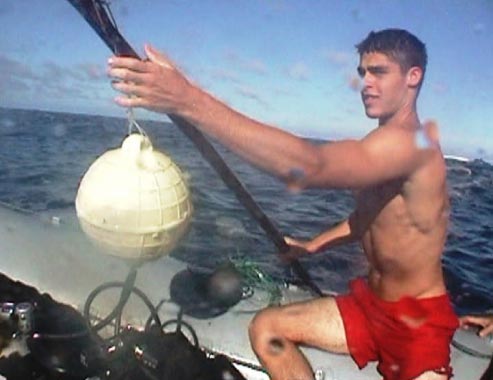
Then our fearless naturalist and dive master, Jonathon, spotted the illegal fishing vessel in the distance – a rather large, rusty looking vessel of some significant tonnage. He actually donned his Ecuadorian park Ranger uniform and set off in a separate tiny panga with great indignance and determination towards the Chilean ship. We learned that the Ecuadorian navy consisted of one gunship that only occasionally patrolled the remote islands of the archipelago.
We didn’t even have radio contact out there so contacting the main islands for help and backup was not an option. We were plenty worried about this big ship full of rough and tumble-looking guys knowing they were fishing illegally in protected waters. For some reason that maybe only the presence of a uniform can explain, they decided to bolt, much to our relief.
Back to our main mission which was diving of course, underwater we went and found more animals.
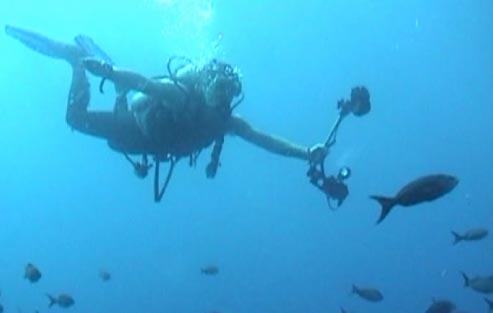
This time some very playful sea lions, one of whom must have known she was on camera.
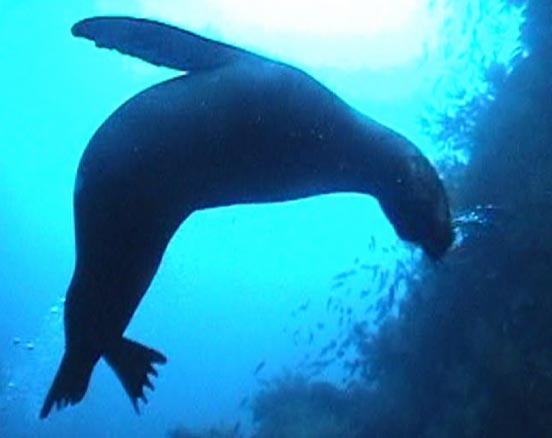
For perhaps two minutes this female sea lion cavorted, spun, somersaulted and swam right at my camera producing some very entertaining video.
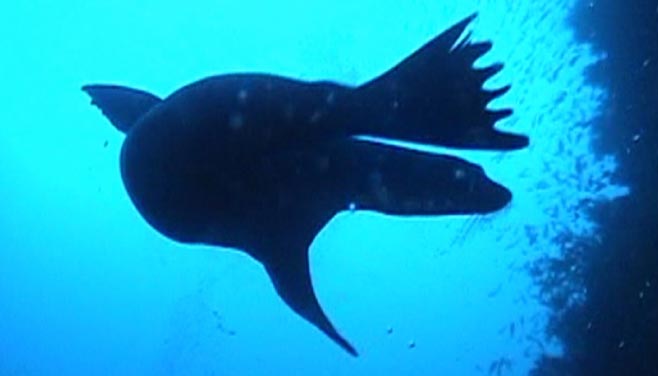
She seemed never to lose track of what maneuvers she had to do so stay within the field of view of the camera lens.
Whale Shark
Then the really big treat came along. It was Brett who took his turn to swim out from the rock wall of the island to get some better visibility into the deep, and did a u-turn back to us with the two signs – “shark” and “big!” We had agreed these would be the signals
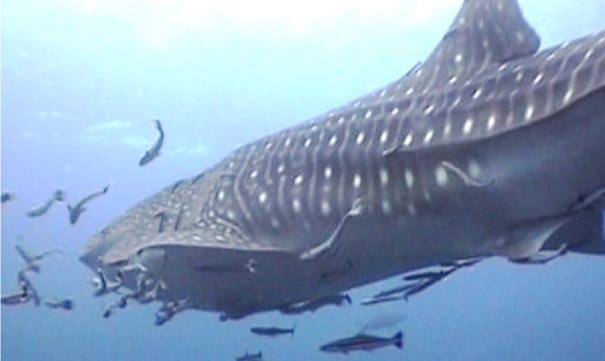
that a whale shark had been spotted. So, Brett, the naturalist and I headed straight out perpendicular from the rock wall into the open ocean at about 60’ depth and soon we spotted a huge dark shadow of a mass that became clearer and more spotted as we got closer.
It was a whale shark indeed, probably some 40 – 45’ in length (whale sharks are the largest fish in the sea) and fortunately swimming only about 1 ½ to 2 knots, a pace we could beat with our flippers.
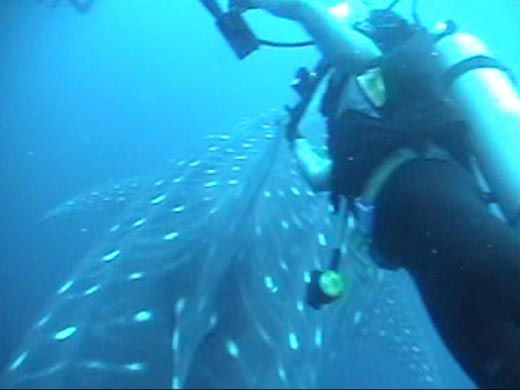
We caught up to him and as you see, we hooked on to his huge dorsal fin for the ride of our lives. For a while all three of us were on for the ride and our fish didn’t so much as flinch!
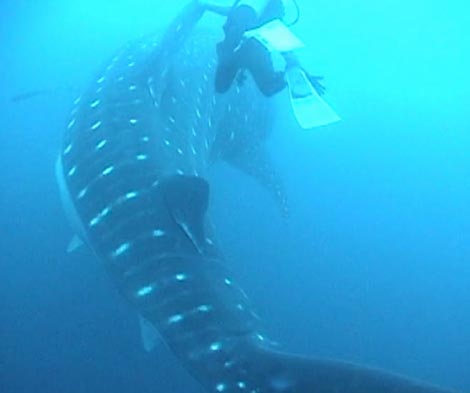
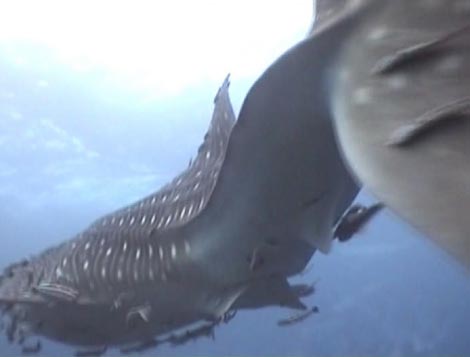
Eventually he started gliding down deeper and at about 110’ we decided it was time to let go. Sport diving limits are 130’ and even less than that some divers risk nitrogen narcosis. As I let go with my video camera still running, I almost forgot that their tails work by swishing back and forth rather than up and down and I almost got whacked – which is about the only way you can get hurt by a whale shark. They don’t eat people.
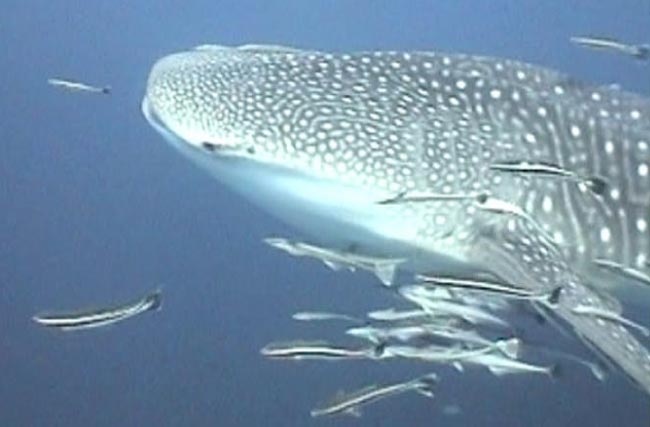
This is a stock photo showing what a whale shark looks like from the front.
Defying Death at Darwin’s Arch
If that wasn’t enough action, getting back to the boat turned out to be literally a life-threatening experience. Recall all the warnings about the dangers of getting too close to Darwin’s Arch and the rocky “mosh pit” surrounding it? Well, Brett and I surfaced sufficiently far from it; we inflated our 3’ high orange “hot dogs” to alert the panga driver we were on the surface and needed speedy retrieval. He spotted us and motored over.
As is standard practice, one at a time starting with me, we began removing our tanks and buoyancy packs while in the water and waited to hand them into the panga while we hung on to the side ropes. We needed to get the heavy equipment into the boat before we could hoist ourselves into the panga. The boat operator was slow in getting to us, and we couldn’t see what he was doing, but we hung on to the side of the boat with our heads just above water level.
What we didn’t know was that the operator, a local, was engrossed in winding up all the fish line that we’d recovered from the illegal Chilean vessel (worth $$ in the local markets in Ecuador) and he wasn’t paying attention to the rapid drift we were making right towards the rocky thrash surrounding the Arch. The first clue we had that we were in danger was a thrust upward of the boat, with Brett and I hanging on to the outside in the water, and then we were slammed down on a major rock just below the surface. The noise of our tanks slamming on the rock was enough of a wakeup call.
The boat operator immediately kicked into action, yanked my tank into the boat (but the crazy motion we were engulfed in prevented me from hoisting myself in) and before getting to Brett, the driver leaped to the little outboard motor, racing it to maximum forward power in an attempt to get out of the maelstrom we’d drifted into – exactly where we shouldn’t be.
Brett curled his legs to keep them away from the spinning propeller, but conditions got worse – the motor didn’t have enough power to get us out, and there was so much water pressure on the boat, slamming up and down and the rocks, it was all we could do to hang on. It seemed we were very close to being smashed to pieces, just as the divemaster had warned.
I had both hands free to hold on, but Brett had only one hand to hold on to the boat line and with the other he was clinging to his backpack and scuba tank that was half off of him. As I looked back at him I saw his head was submerged by the water pressure with just one arm showing, clinging to the side line, for the longest time. He got his head above water, briefly surveyed the situation, heard me shouting “we’re not making forward progress” and he made the snap decision to jettison his equipment – weight belt, tank , buoyancy pack – and the instant he let go of it, the boat lurched forward towards safety. We assessed later that his gear had essentially been acting as a sea anchor and by letting go; we got a kick forward which was enough to get out of the death grip.
Brett shot out of the water and into the boat, grabbed me and helped me in and off we went back to the mother ship. All that was left of the experience was an incredible memory and a negotiation with the boat owners about who paid for the lost equipment.
That split decision to jettison the equipment, no matter how new and expensive it was, saved our lives.
The Orcas (Killer Whales)
We’re not done yet – these are wild waters and there was more in store for us. We dove again the next day, and after the dive with our tanks depleted, we were heading back to the main boat when we spotted a totally unusual sight – a pod of 5 Orcas (Killer Whales) frolicking between us and the Lammer Law in the distance. Not much is known about swimming with Orcas in the wild, but our guide said we’d give it a shot, so with no air left in our tanks, we donned just our fins and snorkels and in we went.
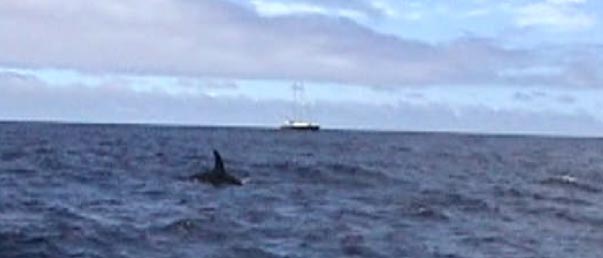
Orcas are black and white – and you can see one passing right under us in the photo below – great excitement.
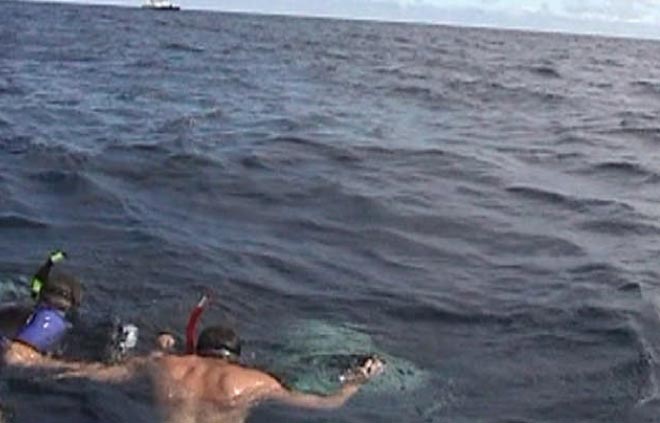
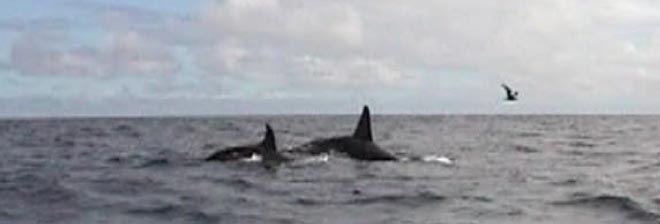
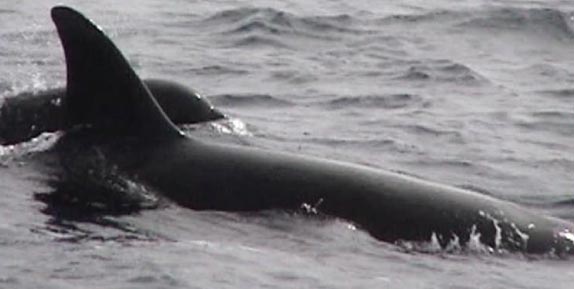
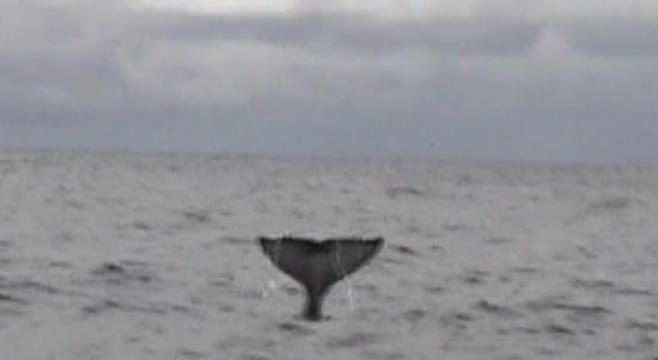
This was our last dive of the week – and if to say a friendly goodbye, one of the Orcas breeched, faced away from us and slowly submerged, waving his huge tail at us as he went.
Another 14 hours of sailing back the main Galapagos Islands, we were also bid adieu by a friendly sea lion. All the animals on the Galapagos are friendly, not afraid of man and approachable – a condition we can only hope Ecuador maintains with strict controls against hunting and fishing.
